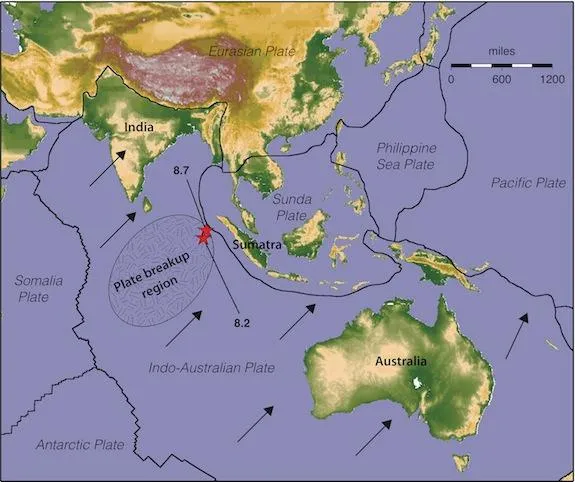Largest Quake of the Year Crossed Fault Lines, Echoed for a Week
/https://tf-cmsv2-smithsonianmag-media.s3.amazonaws.com/filer/20120926020012sumatraquake670.jpg)
The largest earthquake of the year left quite an impression on the earth, but not via mass destruction or tsunamis. In fact, you probably didn’t even hear about it. The 8.7 magnitude earthquake struck on April 11 in the Indian Ocean. Two people are known to have died as a result of the quake, while eight others died of heart attacks.
The quake lasted for 2 minutes and 40 seconds and inspired many scientific studies, including two published today in Nature. In the first, scientists at UC Berkeley announced that the earthquake triggered numerous others as far away as Baja California, almost a week after the original. The scientists announced that they found five times the expected number of earthquakes in the six days afer the event.
“Until now, we seismologists have always said, ‘Don’t worry about distant earthquakes triggering local quakes,’” co-author Roland Burgmann, professor of earth and planetary science at UC Berkeley, said in a statement. “This study now says that, while it is very rare – it may only happen every few decades – it is a real possibility if the right kind of earthquake happens.”
Burgmann calls this quake “one of the weirdest…we have ever seen.” It was the same type of earthquake as caused the 1906 San Francisco disaster—which the U.S. Geological Survey calls “one of the most significant earthquakes of all time”—only fifteen times “more energetic,” according to Burgmann.
“It wasn’t a single fault that produced the quake, it was a crisscrossing of three or four faults that all ruptured in sequence to make such a big earthquake, and they ruptured deep,” he said.

That weird nature of the earthquake was the subject of the second Nature paper, authored by scientists at the University of Utah and UC Santa Cruz. They found that the earthquake was part of a much larger process, the breakup of the Indo-Australian tectonic plate into at least two pieces.
“We’ve never seen an earthquake like this,” study co-author Keith Koper, an associate professor geophysics at the University of Utah said in a statement. “This is part of the messy business of breaking up a plate. … This is a geologic process. It will take millions of years to form a new plate boundary and, most likely, it will take thousands of similar large quakes for that to happen.”
More from Smithsonian.com:
The Science Behind the Japanese Earthquake
Chilean Earthquake Moved City Ten Feet
100 Years of Earthquakes On One Gorgeous Map